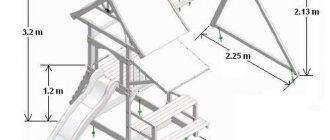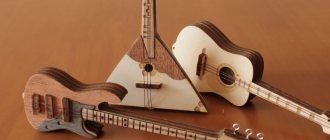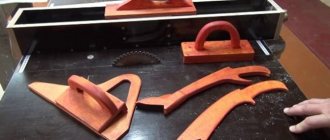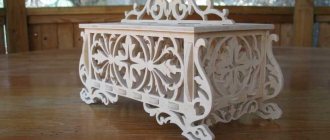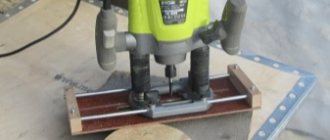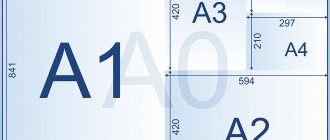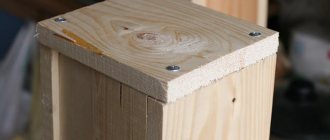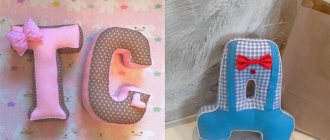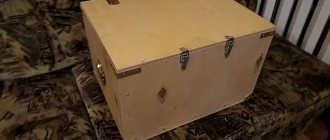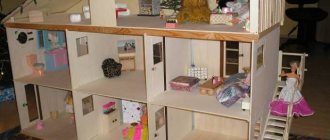DIY wooden cat house made of plywood
I built this cat house with my own hands from wood and decided to share the building experience with you. You can see the entire process of building wooden cat houses in the video or just follow these step-by-step instructions.
Materials:
- Pallet and plywood
- Carpet
- Bucket 20 liters
- Nails and bolts
- Sisal rope
Tools:
- Drill
- Hammer
- Saw (preferably jigsaw or hand saw or circular saw)
- Grinder
- Sandpaper
- Plane
- Stapler
- Sharp knife
Step 1: Gathering materials
Obviously, to build a house you will need pallets. Ask around in places where they may be, for example, at the construction market, most likely they will give them to you for free.
You will then need to divide the pallet into individual boards. This is not an easy task, you will need a hammer and a little patience. Afterwards, remove all nails. You will also need a sheet of plywood for this project. I was able to find a pallet with a plywood top that fit perfectly (and was free).
Step 2: Build the structure
Cut a rectangle from plywood to the size of your future tower. The size of the tower depends on how much space you have, how big your kitty is, how many of them you have, etc. My piece of plywood was already lined with boards on the outside, but if yours isn't, attach boards to the outside for extra support.
Then take the cross beams from the pallet, place them in the form of a triangle and screw them in place using self-tapping screws. Now you can put the tower on its legs, the basic structure is ready.
The two notches in the beam (for forklifts) are curved, so I took a saw and made them rectangular to secure the triangular platforms to.
Step 3: Installing triangular floors
Measure the triangles that will be at the base (top and bottom), then cut them out of plywood. Place the triangles on the inside of your rug and wrap, leaving a few inches on each side to wrap the edges. Cut it out with a knife or scissors, wrap it and staple it. Do this with both triangles, then you can install them into the tower and nail them in place.
Next, cut a rectangular piece of plywood slightly smaller than your base, wrap it in the rug in the same way as the triangles, and secure it on top. Now you have three levels ready. As you can see in the photo, I added triangle blocks below the second level for extra support.
I then took two boards from my pallet and wrapped them in carpet, hammering them into the base and front beams, this will allow the kitty to climb up to the second level and also provide additional support.
Step 4: Build a house
I won't go into detail about the construction of the house I did, take your own approach.
I decided to make the side of the house 25 centimeters wide and the rear 40 centimeters wide. Two boards on each side to make the house tall enough. In total, you get four boards of 25 centimeters and two boards of 40 centimeters. I fastened all the sides with small bars located at each corner. I decided to do the front part of the house after installing the roof.
For the roof, I attached two beams to the front and two to the back (see photo). I made small notches in the ends of the beams to install and secure with nails. I then cut six boards to cover the roof, three on each side.
For the front of the house, I cut a piece of plywood to the shape of the house. Before installation, I cut out the doorway, then nailed down the plywood and the house was finished.
This is optional, but I decided to decorate the house and added a door frame, a sign above the door, and shingles on the roof.
Step 5: Finishing Touches
Almost done... I cut a hole in the top level and secured a rug-wrapped board leading down to the second level. It was a bit of a challenge to cut the hole in the carpet since I had already secured it, but once I had it down it was just a matter of making a hole in the plywood for the jigsaw and cutting out the required hole.
For the pipe I used a 20 liter bucket that I had at home. I made two holes with a drill and cut off the top and bottom with a jigsaw, wrapped the bucket in carpet and sat it down with hot glue since a staple gun wasn't enough. Then I drilled a hole at the second level and in the resulting pipe and secured it with a bolt.
Finally, I took a rope and wrapped it tightly around one of the front legs, this is so that the kitten has something to scratch.
Step 6: Admire the new house
That's all. Place the tower where you want it and place a plywood cat house on top. Since the base is not attached to anything, I added a board under the first level connecting the front legs, this greatly increased the stability of the structure.
masterclub.online
Amazing wooden 3D plywood sculptures
Viktor Yakovlevich Apryatkin is a talented craftsman working in the town of Pushkino near Moscow, making unique garden sculptures of animals and wall heads of various animals using laser cutting technique, using his own drawings and drawings.
Victor, do you have an art education or are you a self-taught artist?
I don’t have an art education, I just liked drawing since childhood, but I didn’t have much practice, so I don’t know how to draw “out of my head.” But if I see a drawing, I will repeat it easily, no matter how complex it may be.
In 1980, I graduated from the Moscow Institute of Railway Transport Engineers with a degree in mechanical engineering. I worked at a factory, and in the 90s I went to work in a cooperative associated with woodworking, because I always liked working with this material.
At some point in my life I went to an exhibition in Izmailovo, saw stained glass windows there and became “sick” with them for several years. I independently studied a lot of specialized literature. He worked mainly in the Tiffany technique, and immediately started with complex forms. My first work using this technique was a shade for a table lamp.
Why did you switch from stained glass to wooden figures, and such unusual ones at that?
The stained glass market is very difficult financially. To do it cheaply is at a loss, but for the time being there weren’t many people willing to buy it at a real price. And then, everything in stained glass had already been invented before me, but I always liked to do non-standard things, to come up with something of my own. The more difficult the task, the better.
Three years ago on the Internet I saw a picture of a garden sculpture - a large rhinoceros made of metal. I fell in love with him at first sight and realized that I just had to make exactly the same. I didn’t yet know how I would do it, but I had an inner feeling that I could do it. I sat for a long time on the first drawings, made test versions from cardboard and, in the end, I got a rhinoceros.
But it was a copy, and not the most complex one, and I wanted something more interesting. Therefore, I modified the rhinoceros, changed the shape and number of ribs and added expressiveness right down to the drawing of the eyes. The working drawing contains about 70 elements.
But the rhinoceros, which, by the way, was recently filmed in the Hacienda program, is still a large model, so I started making smaller models that can be hung on the wall - animal heads. I have drawings of a deer with branchy antlers, an elephant, a buffalo, a ram and a cute little lamb. I also make small models of animals from corrugated cardboard, which the buyer can easily assemble, like a children’s kit by numbers.
I also make clocks, mirror frames, and all sorts of little things like a “perpetual” calendar, “cubes of happiness,” puzzles, outdoor thermometers, and key holders. I love that my works are not only a piece of furniture, but also have a functional purpose.
I see that you also make lamps?
Yes, somehow I came across a picture of an unusual ball-shaped lamp produced by a Finnish company. But their lamps were simple, so I took only the principle of creation as a basis. I have developed several universal drawings and now I am making my own conceptual models of lamps, which can be modified and decorated based on the wishes of customers. In addition to ceiling lamps, I make original sconces in the shape of animal heads.
Now I am preparing an order for a buyer from Khabarovsk - a set of ceiling lamps for a restaurant. They sent me a picture, and I myself developed the diagram, made all the drawings and came up with a technology for how to assemble this lamp without glue, because when assembled they are very large and sending them by mail is inconvenient and expensive.
How long does it take you from developing a drawing to the finished work?
It all depends on the complexity. If this is a simple model, then the drawing will take about 4-5 hours. And if you make, for example, a dinosaur figure, then you can sit for two weeks until you get the desired pattern.
Now it’s easier for me, I’ve gained a lot of experience, so it’s enough for me to see a photograph of the animal in front, profile and half-profile, and based on them I first draw a sketch, and then I draw the drawing in CorelDRAW.
Is it difficult to learn your job?
It's not difficult to learn! In my business, the main thing is the desire and confidence that everything will definitely work out. And you also need basic knowledge of geometry, because the drawing must be accurate, and each element of the plane must be drawn correctly.
What material do you prefer to work with?
I don't work with solid wood or boards because I have a small workshop and I'm not very interested in classic wood carving. Therefore, basically it is sanded plywood with a thickness of 4 mm and 6 mm, which I buy from a trusted supplier. It can be made from 8 mm plywood, but I’m not working with it yet because my laser cutter leaves an unattractive black end. In general, this cutter easily cuts plastics, paper, leather and acrylic glass. But what I love most is working with good plywood. I do not use glue or any other binding materials, I work with tenths of millimeters, so all models are assembled “groove to groove”.
Tell us about your most unusual order?
Well, right now I’m working on an interesting project - the company ordered me full-size figures of animals, and these should not be just figures, but shelves in the shape of animals, on which you can put bottles of wine and dishes. I don’t have such ready-made drawings, so at the moment I’m drawing sketches and doing calculations.
In principle, I can make any figure or object, including garden furniture from thick plywood such as a bench, rocking chair, table or armchair, which will look very unusual precisely due to its ribbed shape.
Are you planning to expand your range or buy new equipment?
I plan to, of course! But my life is not enough to realize everything I would like. I have a notebook where I write down my ideas and plans. I come up with ideas literally every day. The other day I came up with several types of very original lamps in the shape of a jellyfish with an unusual light dispersion pattern. I'm interested in trying to work with different materials. For example, PET sheet 0.5 mm. You can cover it with film and give it any shape, because it bends well and is very durable. Therefore, as soon as I have free time from orders, I draw and make new models.
As for equipment, I want to buy a milling machine just for working with furniture and PET. I’m also thinking about how I can use a 3D printer in my work.
Who do you think your customers are?
My customers, first of all, are very interesting people. And it doesn’t matter whether they bought a rhinoceros for 50 thousand rubles or a key holder with a bull’s head for 500 rubles, it is important that they strive to decorate their home with unusual handmade interior items, they are not afraid of experiments and do not want to be “like everyone else.”
Most often, full-size animal heads and large lamps are purchased by those clients who have a country house and who like non-standard interiors, perhaps in the style of a hunting lodge. Still, wooden sculptures and large lamps impose certain restrictions - in a city apartment it is much more difficult to fit them harmoniously into the interior than in a country house.
But I think about buyers who do not have a cottage, and for them I make small models of animals - most often these are sconces - made of light plastic, which will look beautiful and unusual in the apartment.
Do you like your job?
Yes! I'm waiting for Monday so I can go to work faster. I am not afraid that something will not work out for me, I am always confident that I will succeed. Maybe not the first time, but definitely the fourth time! I think through everything in detail and work according to the principle “everything right should be simple and beautiful.”
The text and photos are copyrighted, that is, mine
Templates for cutting out figures for the garden
Templates for cutting plywood figures for the garden, continuing the theme “Decorating the garden with homemade figures”
Picture templates are suitable not only for cutting, they can be used as regular stencils.
Crafts made from plywood can perfectly decorate a country house interior. They can be made either multi-layered or flat, which can be nailed to a fence or the facade of a country house.
Moisture-resistant plywood, the price of which is not much different from the usual one, is better suited.
Pets
Poultry yard
20.22. .
Some pictures can be used as a template, you just need to enlarge them and print them first.
14.
1
Sep 17, 2015Galinka
6cotok.boltai.com
DIY plywood figurines for the garden
Many of us spend a lot of time in our garden. At the same time, we want to be surrounded by comfort, convenience and beauty. DIY plywood crafts are a wonderful way to self-realize and decorate your garden.
It's nice to play the guitar after eating a piece of sausage. If mice are not caught, it will be bad.
Working with plywood is easy and pleasant. The material is affordable. In the simplest version, the craft will additionally require paints and some screws. You will need a few tools, see the maximum list below.
You can make decorative crafts from plywood for garden beds and fences, fairy tale and cartoon characters for the playground, birdhouses, bird feeders, flower pots, and so on. To learn how to make a birdhouse out of plywood with your own hands, read the special article. Another description will help you make a feeder from plywood. Having asked the question what can be made from plywood with your own hands, we divided all the figures into two groups: simple ones, which are made from one piece of plywood, and more complex ones, which are assembled from several parts.
"Cartoons" for children and adults
Flat plywood figures
Almost all of the examples presented above were cut from one piece of plywood.
To make crafts with your own hands, it is better to use a sheet with a thickness of at least 10mm. In this case, the image will not warp and will last longer. At the same time, it is preferable to use moisture-resistant plywood in the garden.
There is no arguing about tastes - the choice of your favorite option is yours
The procedure for making a figurine from plywood is as follows:
- The contours of the design are drawn on a sheet of plywood with a pencil.
- The craft is cut around the perimeter with a jigsaw.
- The contours and flat surface of the workpiece are processed with emery cloth.
- Painting boundaries in different colors are applied to the part with a pencil.
- The craft is sequentially painted with all colors. Adjacent layers of paint must be completely dry before applying the next color.
Guys from our yard
The finished product can be conveniently secured with self-tapping screws to a fence or wall. Look at the photo: you can “screw” hair, buttons, shoes, a wire tail, and so on onto the craft.
It is important that these elements hold securely, serve for a long time in the sun and rain, and do not pose a danger to people.
Animals, as always, are useful: a deer holds a flower pot
You can make a variety of decorations for your garden with your own hands from one piece of plywood. We have selected several interesting options for you.
Why does a dog need a hare if it has a bone?
These birds are clearly not friends
Storks, swans, chickens: no one will fly away from you!
A grandmother solves an important problem: what should she cook for her grandfather and granddaughter? Grandfather understands well that without firewood there will be no lunch
The granddaughter wastes no time and decides to milk the goat
Volumetric crafts for the garden
It is wrong to say that volumetric plywood crafts for the garden are noticeably more complicated. Of course, you will have to cut out a few parts yourself. But some of them should be painted in one color, which simplifies the work.
It’s hard for a donkey to understand how you can sleep for so long, he’s a donkey!
All parts are prepared according to the scheme described above, and then fastened with self-tapping screws. Of course, a three-dimensional figure looks more interesting. The photo clearly shows that it is necessary to use material with a thickness of 15-20mm. Each detail has its own shape and size. They can be placed optimally on a sheet of material and plywood can be used sparingly.
The dog protects, the cat helps: in general, everything is in order
It’s especially nice when a homemade craft not only decorates the yard, but also performs a useful function. In the photo you see only some examples.
The observer is looking out for birds - or a hedgehog?
Templates and diagrams are not problems
It is better to make templates yourself. Firstly, it’s not difficult, and secondly, you can make templates for your own and a new drawing when you get tired of repeating other people’s ideas. Note that there are a huge number of children's applications for crafts made from colored paper, which are quite easy to cut out of plywood.
The easiest option is to apply the design directly to the plywood. Moreover, if you had an A in drawing at school, it is not at all necessary to copy what has already been done.
Otherwise, you should apply a grid on the drawing you like with a pencil. Then the same grid is drawn on a sheet of material with a pencil. All elements of the design are transferred to plywood “in squares”. Conveniently, the squares in the drawing and the workpiece can have different sizes, that is, the drawing can be transferred to any scale.
The most convenient and modern way to do the work is to use a computer, which is what we did. Almost everyone has a Microsoft Power Point program, where you should copy the picture you like. The program presets the sheet size for printing on a printer to 29.7x21cm.
Setting the print sheet size
We have a piece of plywood measuring 57x77 cm, and we set the size of the pattern based on the availability of material. You must understand that the program takes into account the size of the entire image.
Setting the shape size for printing
Then you need to print fragments of the drawing on the printer, sequentially moving it relative to the sheet to be printed. For ease of printing, a grid of sheets for printing should be applied to the drawing and grouped with the image.
Create a grid of sheets for ease of printing
Now the sheets should be glued into a single image and cut along the contour after the glue has dried. The paper template is placed on a sheet of plywood and outlined with a pencil. Subsequently, individual parts of the drawing are sequentially cut off from the template and also transferred with a pencil to the workpiece. You can cut it out!
How to save your work longer
It will be very disappointing if the handicraft you made yourself peels off and warps from the first rain. So it is better to take a number of measures to save your own work.
Firstly, it is better to use moisture-resistant material. Secondly, it is necessary to impregnate it from moisture, for example, with Pinotex. Acrylic and oil paints can be used. It is important that they are for external use. If you want to leave the natural color of the wood, the craft should be coated with transparent yacht varnish.
Prepare for the fact that the figurine will have to be repainted every two to three years. If the plywood begins to delaminate, it must be puttied before painting, for example, with Silacryl sealant. It is very effective to hide the craft from bad weather during the winter.
Let the video help you in your work. All that remains is to wish you good luck!
Share with friends!
samodelino.ru
Deer head made of plywood: choosing a drawing, cutting and assembly, where to buy a ready-made one
A deer head made of plywood is created in beige or with a paint coating. It differs from the usual form, ensuring satisfaction of the requirements for creating an interior in a hunting style. To make a decorative element yourself, you will need to prepare individual parts cut out according to a template.
Plywood deer head
Drawing selection
The deer head made of plywood in the drawings attracts with its original design and variety of parameters. They match the appearance of the building. Selecting large parameters stands out strongly on the walls and gets in the way. The design of small sizes will be similar to a toy.
The plywood deer head template corresponds to standard parameters that reflect real objects. That is, after assembly the product coincides with the original.
The number of details included in the decoration is taken into account. There are situations when two externally identical products have a different number of elements.
Plywood animal head
If you create a deer head from plywood with your own hands, instructions or an explanatory note are attached to each diagram. It displays the most complex parts or connections, allowing you to describe the method of their development.
Attention!
Experts recommend initially making all the parts from paper and assembling. In the future, these elements serve as patterns for working with plywood.
Material for production
If you need a deer head made of plywood, buying the product will not be difficult. However, it is cheaper to reproduce the product yourself. The work uses a plywood panel treated with impregnation and paint. To give maximum effect, several shades are used.
Deer head made of plywood boards
In some cases, you can use bakelite-based plywood, as it has moisture-resistant properties. But this preparation is very wasteful. They are used to decorate façade surfaces or garden plots.
The glue is selected from ready-made offers or created on the basis of PVA. After development, the product is protected from moisture. For this you need impregnation and paint.
If plywood is used for facades, a bakelite-based material that can be painted is selected for this purpose.
Before applying the primer, the structure is treated with a fine abrasive. This helps to correct edges and eliminate lint on the coating.
Plywood trophy in the form of a deer's head
What else will be needed during the manufacturing process?
In addition to a plywood sheet and a photocopy of the drawing, you need to prepare copy paper, a non-writing pen, a sawing table, a jigsaw, abrasive sandpaper, a file, a sharp knife, PVA glue, an awl, a 4 mm drill, a drilling machine or an electric drill.
Preparing a sketch
The pattern is printed in real scale (44 - 48 cm). The layout will fit on an A2 sheet. If it is not possible to print in this format, the drawing is divided into separate sketches placed on A4. The sheets are glued together into a single drawing and then cut out.
If you have a good stationery knife, cut out elements from cardboard panels according to the pattern. The width of the slots for joining products corresponds to the width of the plywood. This should be taken into account when cutting. You will need 2 parts for the second pattern.
Plywood decoration in the form of an animal head: diagram
Elements of the finished structure are assembled. They should be numbered first. Using template elements, you can assemble a plywood product.
Based on the external appearance of the deer, you can paint, paste, apply a design, or leave it in its original form.
Features of applying a pattern to the material
The main requirement for pressed solid wood slabs is a smooth coating that excludes visible defects. Typically, pressed plywood is used to create decorative products. Sanded plywood elements with a layer of 4 mm and 6 mm can be replaced with an 8 mm solid. The assembly of volumetric products is carried out “groove to groove”.
Deer head made of plywood boards
After selecting the base for cutting, the drawing of the first element is applied. Its blank had already been previously found on the Internet and then printed out on a printer.
The outline of the workpiece is cut out using a stationery knife. The drawing is fixed on a plywood sheet using double-sided tape or PVA glue (it is not recommended to carry out permanent gluing, since the sketch will be removed in the future). Use a marker or pencil to trace the outline.
Upon completion of the work, regarding drawing the outline, the paper figure is removed from the sheet and the design is cut out.
What's the best way to cut
To work with plywood, use a jigsaw:
- Manual. A simple and understandable tool designed for household purposes. Any beginner can easily handle it.
- Jigsaw. Using an efficient and fast device allows you to create figures in the shortest possible time.
- Stationary product. Used to create high-quality drawings in a short period of time. The main criterion is the presence of a bed and rigid fixation of the saw.
To carry out the process, a nail file is inserted into the jigsaw - made of metal, coated with diamond. A small gap is made in the drawing on the raw material for inserting a nail file and cutting is carried out along a given contour for cutting out of a plywood sheet with a jigsaw.
Subsequently, the figure is carefully cut out along the previously created contour, ensuring smooth bends.
Plywood decoration in the form of hunting treofey: cutting
Tenon joints
At the end of the marked eye, at a distance of 2 mm, a through gap with a cross-section of 4 mm is drilled.
The groove is cut using a jigsaw. The jigsaw file moves from the inside of the marking.
After the cut has been formed, it is necessary to ensure control using a sanded piece of plywood from the workpiece. This template fits tightly into the groove.
Where can I buy
Among the companies offering to purchase a deer head made of plywood, we can highlight the following distributors.
For sale is a decorative deer head made of plywood. You can buy a handmade product in 9 color options, made like a 3D puzzle from sheet material, 4 mm thick.
- Location:
st. Novocheremushkinskaya 17, Moscow - Call here:
(495) 10 599 11 - Find out more:
https://dg-home.ru/
- Location:
st. Atamanskaya 3/6, St. Petersburg - Call here:
(812) 30 997 94 - Find out more:
https://zpos.ru/
diagrams, templates of flat and three-dimensional products
Plywood is a universal material that is usually used in furniture production and private construction.
With a little skill and creative imagination, you can use this building material to make children's toys, decorative crafts for your garden plot, and small household items. It is noteworthy that this does not require special skills or knowledge.
Let's see what interesting plywood products you can make with your own hands, having a little free time and patience.
Don't forget to share with your friends! The content of the article
Why plywood
The choice in favor of plywood was not made by chance. Unlike simple wood, this material has the following advantages:
- strength. The structure of the sheet is multilayer, which ensures a certain rigidity and resistance to deformation;
- availability. Available in any hardware store and sold in an affordable price segment;
- ease of processing. Cutting crafts does not always require a power tool; you can get by with an ordinary jigsaw;
- safety. The material is environmentally friendly, so you can even make toys from it without fear that your child will develop an allergy.
Plywood initially has a smooth surface, so it does not require additional sanding.
Products are divided into grades, which differ not only in cost, but also in quality. For crafts, they usually use sheets of the 1st and 2nd grades, which do not have veneer delamination, chips and other defects. If the decorative decoration is intended to be used in the garden, it makes sense to give preference to moisture-resistant plywood.
Figurines for the garden
DIY plywood crafts for the garden are the most practical and inexpensive way to decorate your garden plot. Here you can fully realize your creative potential by making your garden or flower bed more original and interesting.
Select a template
The key feature of plywood is its versatility. From a flat sheet you can cut out almost any figure using a template. A cat climbing over a fence at the dacha, holding a piece of sausage in its teeth; a curious man watching his neighbors through binoculars; a herd of reindeer grazing in a flowerbed. There are a lot of options, and crafts can be flat or voluminous.
It is better for inexperienced craftsmen to start with simple flat figures, which are made in 1.5-2 hours, maximum in a day.
As a sketch, you can use the ideas of other masters, look at the design options for your personal plot on the Internet, or create your own funny drawing. It is better to draw the template on tracing paper or graph paper, and then carefully transfer it to the plane of the plywood sheet. A good option is to create an image in Microsoft Power Point.
You can make a high-quality sketch for a plywood craft using this application according to the following scheme:
- transfer your favorite drawing to the working window of the program;
- go to the scaling section and set the aspect ratio based on the size of the existing sheet of plywood;
- break the finished drawing into fragments;
- print them one by one on the printer.
After this, the individual fragments of the picture are glued into one sheet, the template is carefully cut out along the contour, applied to the plywood and traced with a simple pencil. This operation takes no more than half an hour, but this technique allows you to create effective templates, even without artistic abilities.
Manufacturing technology
After drawing the sketch on a plywood sheet, the figure needs to be cut out.
For thin sheets of plywood, a regular jigsaw is suitable; thicker material can be cut faster with an electric tool.
The cut should not be made strictly along the contour, but leaving a margin of about 1 millimeter. This is a common precaution so that the canvas does not accidentally move to the side and ruin the template. If the decorative decoration involves through cuts, the starting groove is drilled with a drill, after which a jigsaw file is passed through the resulting hole.
After completion of the work, the remaining irregularities are removed with a fine file or sandpaper.
Finishing
Of course, even the most original figurine requires at least painting to become brighter and more interesting.
Before applying the design, the entire surface that is supposed to be painted must be treated with fine-grained sandpaper, making the plywood a little rough. This will ensure better adhesion of wood to paints and varnishes. Then you need to remove the wood dust remaining after treatment and degrease the surface with a solvent.
If the template is multi-colored, it is recommended to mark the demarcation lines with masking tape. It is better to paint fragments of such crafts separately to avoid accidental mixing of colors.
The paint is applied in multiple layers, with each subsequent layer applied only after the previous one has completely dried. This painting scheme will make the design more durable: the paint will not fade in the sun or peel off after rain.
At the final stage, the finished surface can be varnished to make the figurine more resistant to environmental influences. The varnish is applied according to a similar scheme: a multi-layer texture with the obligatory drying of each layer.
Note! If the figurines are removed from the garden in winter, the paint will have to be renewed approximately once every 3-4 years.
To increase the moisture resistance of the design, it is recommended to choose acrylic paints for outdoor use. Materials for facade work are more resistant to ultraviolet radiation and moisture and reliably protect wood.
Volumetric figures made of plywood
You can easily make beautiful, three-dimensional crafts in 3D format with your own hands. In general, such products are manufactured similarly to the scheme given above. The only caveat: the figure will consist of several elements.
For example, if we are talking about a rooster, which will serve as a good decorative decoration for the lawn, then the three-dimensional figurine will consist of the following parts:
- body, including head and tail;
- two wings: one on each side;
- a pair of paws.
Each element is cut out separately according to the drawn up sketch. After which the figure is assembled into a single whole using glue or decorative nails. Using a similar scheme, you can make any animal (cat, dog, bear), mushroom, gnome, lantern and much more. Small-sized souvenir items are also cut out and placed on a shelf.
Children's toys made of plywood
Almost any children's toy can be made from plywood. For the little ones, pyramids or mobiles that hang above the baby’s crib are suitable. For example, you can make a pendant of multi-colored stars, which are attached to a fishing line and rotate slowly, evoking pleasant dreams.
For older children, various cars, tanks, airplanes, and puzzles are suitable. It is noteworthy that you can involve a child in the creation of each toy, which will not only allow you to have a fun time, but also teach the boy how to use the instrument.
Girls will not be left out either. You can cut a dollhouse out of plywood and make all the interior furnishings: cribs, chairs, dishes. The appearance of crafts for children made from plywood is much more interesting than that of factory toys, because they are made with soul. They can be given for a birthday, and it will be a very unusual and pleasant gift.
Important! It is recommended to glue children's toys only with PVA; for finishing, use water-based varnishes.
Such compositions do not contain toxic substances, therefore, they will not create health problems, even if the child puts the toy he likes into his mouth.
Setting up the kitchen
Taking into account the specifics of the application, kitchen crafts are made from dense, water-resistant plywood.
This material is not afraid of moisture and steam, so it can last for several years. Plywood is usually used to make carved shelves, boxes for storing spices and other necessary small items, cutting boards, hooks for potholders, and souvenir refrigerator magnets.
If you have some experience, you can assemble an entire kitchen set with your own hands, which will not differ from the products of furniture factories. To do this, use thick sheets of plywood, a jigsaw or a hacksaw. And of course, you need to have some free time and desire.
treegid.com
